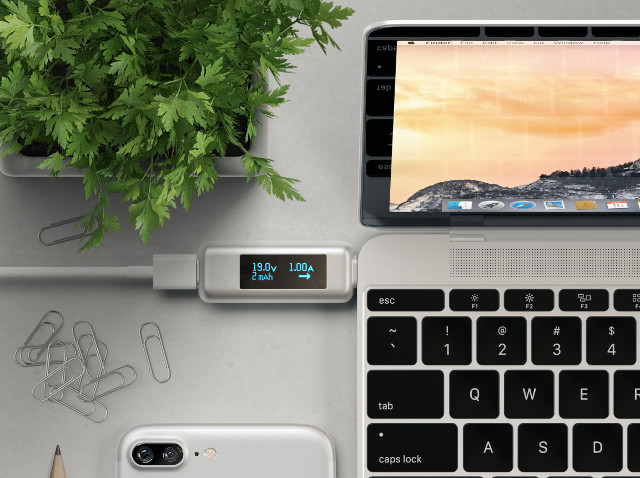CHARGER Doctor is a popular USB power meter for USB 2.0 ports that can help you check whether your charger delivers the promised amperage, and if you are dealing with USB powered device you can easily measure the power drawn by that device. But we are now in 2017, and USB type C has become more and more popular, and can deliver higher voltages higher than 5V, as well as higher currents. So if you are looking for USB type C power meter, Satechi has you covered.
 Satechi USB-C power meter key features and specifications:
Satechi USB-C power meter key features and specifications:
- Voltage Range – 4V-20V
- Current Range – 50mA-10W
- Max readable Power – 65W
- Indicates power over time (mAh) and current direction (e.g. charger to laptop, or laptop to phone).
- USB 3.1 data pass-through supported
- Dimensions – 6.3 x 2 x 0.8 mm
- Weight – 8.6 g
Beside just measuring power usage, several blogs report this USB-C power meter might be able to help you detect bad cables or power adapters, as people have reported frying equipment in the past, and a USB Type-C Authentication Specification has even been announced last year to work around the issue. I’m not sure how you are supposed to do to test cables/adapters safely, as user reviews indicate the display will only turn on if you are actually charging a device.
The meter is currently for sale for $30 on Amazon US, and you may find more details on the product page.
Via Liliputing & Gizmodo

Jean-Luc started CNX Software in 2010 as a part-time endeavor, before quitting his job as a software engineering manager, and starting to write daily news, and reviews full time later in 2011.
Support CNX Software! Donate via cryptocurrencies, become a Patron on Patreon, or purchase goods on Amazon or Aliexpress





Why only up to 65w if he can measure to 10Ampère???
@Loïc
Just google ‘USB PD profiles’ (PD == power delivery) and there ‘profile 4’, then look at the tiny contacts of Type C connector. The average USB-C cable is limited to 3A which translates to 60W (profile 4: 20V@3A) which is also the reason you see only 65W rated USB-C PSUs around. The 65W rating is to compensate some losses due to cable and contact resistance and I would assume ~60W will be the highest value you’ll ever see when measuring anything connected through Type C connector.
@tkaiser
We do have 100W Type-C cables, but they are not that common, e.g., https://www.amazon.com/USB-Type-C-Coaxial-Cable-JUCX01/dp/B01B3N3VYE
@tkaiser
Apple already offers a 87W PSU http://www.apple.com/shop/product/MNF82LL/A/87w-usb-c-power-adapter
@JM
Sure, but better consider the necessary ‘Apple USB-C Charge Cable (2 m)’ proprietary. Without this special cable you remain at ~60W while charging. Since the cable according to specs only allows USB 2.0 data transmissions I would assume Apple (mis)uses the SuperSpeed or other pins/wires for powering too — see https://en.wikipedia.org/wiki/USB-C#Cable_wiring for details.
davidlt : @tkaiser We do have 100W Type-C cables Sure, following latest USB-C spec. But is there any Type C equipped source or sink in the wild that would make us of this? Increasing amperage from 3A to 5A with these tiny contacts is challenging and even with ‘profile 4’ at 3A plug/barrel get pretty hot when charging. At least Apple chose a different way with their 15″ MacBook Pro and they increased the amount of VBUS/GND pins/wires instead of amperage (at least that’s my assumption when reading through the description of the ‘special charge cable’). And that might be… Read more »
@tkaiser
That is total nonsense. There is nothing proprietary with that cable or Apple’s 87W PD.
Please spend some time reading some good resources on USB-C PD before more “tiny pins” style comments. I suggest https://plus.google.com/+BensonLeung for example.
Hmm… always wanted to measure real-world consumption of Sonnet’s ‘Twin 10G Thunderbolt 2 to Dual-Port 10 Gigabit Ethernet Adapter’ we use at a lot of customers to interconnect a bunch of Macs with high bandwidth demand to the central server. But I fear the powermeter is incompatible to be used in Thunderbolt 3 mode since it’s mentioned nowhere?
@tkaiser
Silly me, totally forgot the 10GbE adapter needs an own PSU and just read the ratings: 60W. Anyway, time to read some specs since more and more customers buy latest gen MacBook Pro and now all the adapter/converter fun starts again (especially having power delivery differences in mind). While I really appreciate Type C connector simplifying a lot of things it gets somewhat complex in Apple land with TB3 as ‘superset’ of USB-C 🙂
So you mean that the 87W PSU when combined with a 5A rated/enabled cable like the aforementioned j5Create JUCX01 will lead to ‘Profile 5’ negotiated and increasing VBUS to 5A? Do you have any reference for this?
@davidlt
Amazon doesn’t ship JUCX01 to Germany and the cable seems to be not available here anywhere else (only JUCX03 which can be considered a fail). Any other ‘profile 5’ cable recommended and available here (or in France at retailers since I’m doing some ‘home office’ next week there and want to try out such a cable together with the 87W Apple PSU and the 15″ MBP)
@JM
Thanks for insisting! In the meantime after looking through the descriptions of a lot of USB-C charging cables I came to the conclusion that I was trapped in a chain of wrong assumptions (starting at the ’65W max claim here). Even many 3A only cables have no SuperSpeed capabilities so most probably Apple’s PSU and cable are 5A capable. Back on topic: regarding the ’65W max’ I asked Satechi tech support and get back to here when I receive an answer.
Shipping costs are are little extreme from Amazon and satechi – more than doubling the units cost.